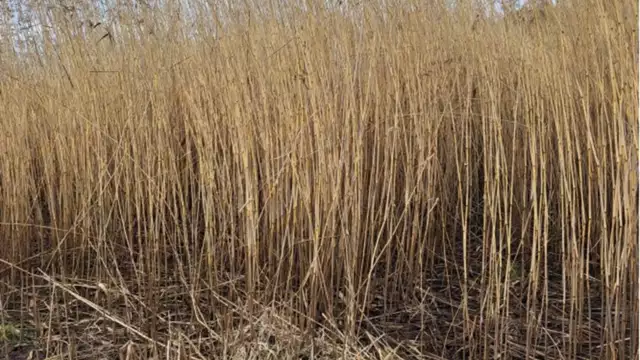
Common reed – from coastal restoration to novel biomaterial
Published: 25.03.2024 / Publication / Blog
In this blog post, an overview of the role of Baltic Sea reed beds is presented in the context of harvesting reed and using it as a sustainable biomaterial. This overview will give perspective to the work that has been initiated at Arcada in the Baltic Reed project. The blog post will also introduce the Baltic Reed project and how Arcada is working together with partners towards using reed as a sustainable material.
What is common reed?
Common reed (Phragmites australis, reed) is a cosmopolitan grass that is a common sight on the coasts of the Baltic Sea. Reed can grow in water or on land, making it a part of both aquatic and terrestrial ecosystems. Its roots attach the plant to the soil or bottom sediment, as the stems can grow up to several meters’ height in the air. In the Baltic Sea, reed is growing in the transitional zone of the littoral ecosystem, where it has an important role in nutrient cycling and in creating a habitat for other life forms, such as fish, birds and insects. Reeds grow a new biomass above ground every year. Fresh reed biomass in the summer is rich in nutrients, whereas in the winter, the stems become dry and hard and contain less nutrients.
Eutrophication in the Baltic Sea
Eutrophication is one of the biggest problems affecting ecosystems of the Baltic Sea (HELCOM 2023 a). Almost 80 % of estimated coastal waters are in bad-to-moderate status, only 5,6 % in good status (rest not assessed) (HELCOM 2023 b). Eutrophication of the Baltic Sea leads to increased primary production by planktic algae and autotrophic bacteria, macroalgae and macrophytes. The produced biomass increases the amount of organic material in the sea leading to increased decomposition and oxygen consumption, which in its turn affects how nutrients cycle between water and sediment. This can lead to internal loading of phosphorus from sediment back to water.
Baltic Reed project working for improved coastal and marine environment
During the last decades several projects have both internationally and locally in Finland aimed at harvesting reed and using the biomass as material or as a source of energy (list of reed projects with Finnish participation, Centre for Economic Development, Transport and the Environment in Southwest Finland). Internationally, reed has been used for several purposes such as for industrial material (e.g. thatching roofs in especially central Europe) and for energy and agriculture (Köbbing, J. F. et al. 2013).
Arcada is now participating in the three-year Central Baltic Interreg project, Baltic Reed, led by John Nurminen Foundation, with partners in Sweden, Finland and Aland Islands. The project aims at removing nutrients from the Baltic Sea by harvesting reed biomass, creating value chains for reed use in both existing and novel applications and engaging companies in using reed. In the project, Arcada will explore solutions and innovative approaches to use reed and analyse value chains from reed with the other project partners. Assessing the use of reed as a biomaterial involves not only technical and economic analysis, but even analysis of nutrient removal and climate impact of reed harvesting for different applications. Therefore, knowledge in ecology, economy and material science is needed. Project partners are working closely with entrepreneurs such as reed harvesting companies, end-users in different fields, research institutes and environmental authorities to tackle the bottle-necks in reed-based value chains. The goal is to promote reed use by companies, both for existing and for novel purposes. Arcada will concentrate on reed use development and innovations, integrating the project in both research and education by e.g. innovation hackathons with students.
Nutrients can be removed by harvesting reed
By harvesting reed, nutrients and organic material can be directly removed from the Baltic Sea. But as human activities have increased eutrophication in the Baltic Sea, even actions to counteract this development will have effects that need to be assessed. Changes in nutrient circulations and food webs in both aquatic and terrestrial ecosystems are complex. In the Baltic Reed project, an estimate of 10 kg of phosphorus per hectare of fresh summer harvested reed is used to evaluate the nutrient removal potential in the harvested biomass. However, the amount of nutrients in reed biomass varies both seasonally and spatially. Removal of decomposing biomass, rich in phosphorus, nitrogen and carbon, leads to less oxygen consuming biomass. But in order to estimate how removing reed biomass affects hydrodynamics and nutrient cycles in the coastal ecosystems, the ecology of reed beds and their role in these systems has to be considered.
What is the role of reed beds in nutrient and carbon cycles of the Baltic Sea coastal ecosystems?
Thick colonies of reed affect both physical and chemical characteristics of the water and sediment, both directly and through changes in the hydrodynamics of the area. Reed beds can lower water turbulence and the frequency of sediment erosion events and inhibit sediment resuspension which otherwise can lead to phosphorus resuspension from sediment to water (Horppila et al. 2013, Kaitaranta et. al 2013, Karstens et al. 2015). On the other hand, low-turbulence and thus low-oxygen areas inside reed beds can in some situations lead to phosphorus release from the sediments, therefore enhancing eutrophication (Karstens et al 2015). It has also been estimated that reed wetlands can actually shift from nutrient sinks to nutrient sources during different seasons (Berthold et al. 2018), and that changes in these phosphorus release mechanisms can occur even during periods of only a few hours (Karstens et al. 2015).
In addition to how reed beds affect nutrient flows in coastal areas of the Baltic Sea, effects on the climate need to be considered also. Reed plants themselves can affect the oxygen situation in the sediment, and even dead, still-standing culms of reed can offer a pathway for gas exchange to and from sediment during winter (Brix 1989). Net effects of reed wetlands have been studied to understand if they actually act as sinks or sources of green-house gases (Brix et al. 2001, Myllykangas et al. 2020) and there are ongoing studies in this field. But it is more difficult to interpret these results to estimate how reed beds’ management affects these processes on the Baltic Sea coasts.
It is generally considered that, in order to maximise the removal of nutrients, reed should be harvested in the summer when the biomass has its maximal nutrient contents (e.g. Berthold et al. 2018). This has also been the conclusion in several previous reed projects. On the other hand, according to expert evaluations of reed beds’ ecosystem services, summer harvesting could lead to decreased erosion control and counteract nutrient removal effects (Karstens et al. 2019). Even if these erosion and resuspension related effects can be estimated, ecosystem manipulation can have ecological cascade effects that are difficult to estimate. It has been shown that human induced changes in macrophyte communities can lead to shifts in ecosystem balance and that reed beds can actually have an important role in maintaining this balance (Kornijów 2018). Reduction of emergent macrophyte density from organic-rich littoral sediments could turn sediment accumulation areas to erosion bottoms and have consequences for the water quality (Horppila et al 2013). These feedback mechanisms are complex and vary according to local situations. Changes in eutrophic aquatic ecosystems can have threshold mechanisms where shifts from one state to another happen after a certain ecological threshold in the system is exceeded (Scheffer et al. 1993, Kornijów 2018). For example, a macrophyte-dominated clear-water state ecosystem can turn into a turbid, algae-dominated system where a change back is difficult to achieve due to multiple strengthened feedback mechanisms. These mechanisms should be considered in relation to the specific local conditions and to the harvesting strategy (land or water growing reed, winter or summer harvesting) when aiming at improvements of the status of aquatic ecosystems by removing reed biomass. The effects of climate change, such as increased precipitation especially during winters, more frequent storms and other extreme weather events, should also be considered for the Baltic Sea region.
Assessing reed use as material
How reed could be used as a novel biomaterial should be done by weighing the costs and benefits. It needs to be clear which parameters are used and for what purpose. For example, harvesting reed in the summer results in greater removal of nutrients but the use of the fresh reed biomass is different compared to dry and hard lignocellulose material from winter reed. Harvesting costs and the value of the biomass for different uses can be measured in money. It is much more complicated to quantify the value of nutrient removal from the Baltic Sea, carbon sequestration in harvested biomass, biodiversity, habitat restoration, ecosystem services, cultural significance, life cycle and recyclability of new materials and circularity of reed-based value chains.
In the Baltic Reed project, these value chains will be further analysed for different uses of the reed. During three years, the Baltic Reed project will result in supporting existing value chains and piloting for new uses. We will also increase knowledge about the material and how harvesting reed affects the coastal areas. After the project years, we hope to have initiated new business ideas and promoted harvesting and using reed, leading to new business and job opportunities. The challenge of using materials from nature is to balance the costs and benefits to both humans and nature by using materials in an economically viable and ecologically sustainable matter.
References
The Baltic Reed project webpage: https://centralbaltic.eu/project/balticreed/ External link
Berthold, M. Karstens, S., Buczko, U. et Schumann, R. 2018. Potential export of soluble reactive phosphorus from a coastal wetland in a cold-temperate lagoon system: Buffer capacities of macrophytes and impact on phytoplankton. Science of the Total Environment 616–617: 46–54.
Brix, H., Sorrell, B. K. & Lorenzen, B. 2001. Are Phragmites-dominated wetlands a net source or net sink of greenhouse gases? Aquatic Botany 69: 313–324.
Kaitaranta, J., Niemistö, J., Buhvestova, O. and Nurminen, L. 2013. Quantifying sediment resuspension and internal phosphorus loading in shallow near-shore areas in the Gulf of Finland. Boreal Env. Res. 18: 473–487.
List of reed projects with Finnish participation, Centre for Economic Development, Transport and the Environment in Southwest Finland. https://www.ely-keskus.fi/web/ruoko/han… External link
HELCOM, 2023 a. Thematic assessment of Eutrophication 2016-2021. Baltic Sea Environment Proceedings n° 192
HELCOM, 2023 b. State of the Baltic Sea. Third HELCOM holistic assessment 2016-2021. Baltic Sea Environment Proceedings n°194
Horppila, J. Kaitaranta, J., Joensuu, L. & Nurminen, L. 2013. Influence of emergent macrophyte (Phragmites australis) density on water turbulence and erosion of organic-rich sediment. Journal of Hydrodynamics, Ser. B. Volume 25 (2): 288–293.
Karstens, S., Buczko, U. & Glatzel, S. 2015. Phosphorus storage and mobilization in coastal Phragmites wetlands: Influence of local-scale hydrodynamics. Estuarine, Coastal and Shelf Science 164: 124–133.
Karstens, S., Inácio, M. & Schernewski, G. 2019. Expert-Based Evaluation of Ecosystem Service Provision in Coastal Reed Wetlands Under Different Management Regimes. Front. Environ. Sci. 7:63.
Kornijów, R. 2018. Ecosystem of the Polish part of the Vistula Lagoon from the perspective of alternative stable states concept, with implications for management issues. Oceanologia 60, 390–404.
Köbbing, J., Thevs, N., & Zerbe, S. 2013. The utilisation of reed (Phragmites australis): a review. Mires and Peat 13, 1–14.
Myllykangas, J-P, Hietanen, S. & Jilbert, T. 2020. Legacy Effects of Eutrophication on Modern Methane Dynamics in a Boreal Estuary. Estuaries and Coasts 43:189–206.
Scheffer, M., Hosper, S.H., Meijer, M-L., Moss, B & Jeppesen, E. Alternative equilibria in shallow lakes. Trends Ecol. Evol. 8 (8), 275—279.

